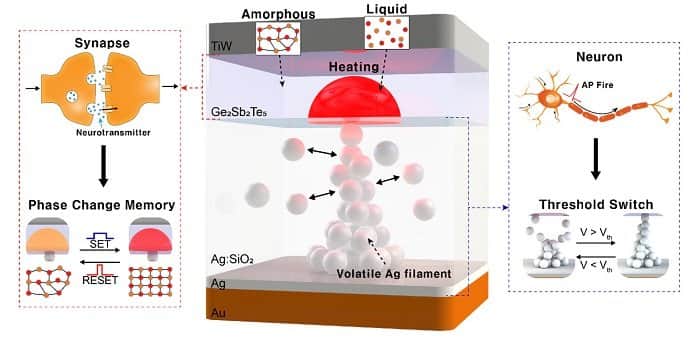A team of researchers at the Korea Advanced Institute of Science (KAIST) has reported a nano-sized neuromorphic memory device that emulates neurons and synapses simultaneously in a unit cell. The new advancement is a major step towards achieving neuromorphic computing that can mimic the human brain with semiconductor devices.
The research was published in Nature Communications.
Realizing AI With Neuromorphic Computing
Experts are working on getting neuromorphic computing to realize artificial intelligence (AI) by mimicking the mechanisms of neurons and synapses in the human brain. Current computers cannot provide certain cognitive functions of the human brain due to several limitations, but their potential has been explored thoroughly.
With that said, current Complementary Metal-Oxide Semiconductor (CMOS)-based neuromorphic circuits connect artificial neurons and synapses without synergistic interactions. The implementation of neurons and synapses has proven to be difficult.
To overcome these limitations, the research team led by Professor Keon Jae Lee from the Department of Materials Science and Engineering implemented the biological working mechanisms of humans by introducing the neuron-synapse interactions in a single memory cell. This differs from the traditional approach of electrically connecting artificial neuronal and synaptic devices.
Artificial Synaptic Devices
The artificial synaptic devices that were previously studied are often used to accelerate parallel computations, which demonstrates clear differences from the operational mechanisms of the human brain. By implementing the synergistic interactions between neurons and synapses in the neuromorphic memory device, the mechanisms of the biological neural network were able to be emulated. The neuromorphic device can also replace complex CMOS neuron circuits with a single device, which improves scalability and cost efficiency.
The human brain is made of a complex network of 100 billion neurons and 100 trillion synapses, and the functions and structures of these can change depending on external stimuli, which allows them to adapt to the surrounding environment. The neuromorphic device developed by the team enables short-term and long-term memories to coexist using volatile and non-volatile memory devices that mimic the characteristics of neurons and synapses. Volatile memory is represented by a threshold switch device, while phase-change memory is used as a non-volatile device. With two thin-film devices integrated without immediate electrodes, the funcional adaptability of neurons and synapses could be implemented in the neuromorphic memory.
“Neurons and synapses interact with each other to establish cognitive functions such as memory and learning, so simulating both is an essential element for brain-inspired artificial intelligence,” Professor Lee said. “The developed neuromorphic memory device also mimics the retraining effect that allows quick learning of the forgotten information by implementing a positive feedback effect between neurons and synapses.”
Credit: Source link


Comments are closed.